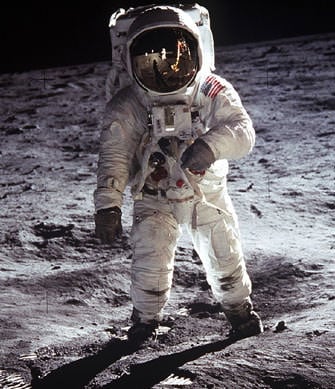[/caption] Buzz Aldrin is approaching 80 years of age, and he's decided it's not time to mince words. Not only is he
rapping about what he accomplished
during his astronaut career, but in today's
online version of Popular Mechanics
Buzz wrote an article outlining what he believes NASA's path and vision should be -- for the next few years and into the next few decades. He's a man with a plan, and he calls it the "Unified Space Vision." He will present his plan to the Augustine Commission, an independent council appointed by President Obama to review NASA's human spaceflight objectives.
So just what does Buzz have in mind?
Buzz writes, "It's a blueprint that will maintain U.S. leadership in human spaceflight, avoid a counterproductive space race with China to be second back to the moon, and lead to a permanent American-led presence on Mars by 2035 at the latest. That date happens to be 66 years after Neil Armstrong and I first landed on the moon—just as our landing was 66 years after the Wright Brothers' first flight."
Buzz has proposed other plans in the past, but this one is different, so he's not just singing an old tune. It's also well thought-out and it has many facets that will appeal to both the Moon lovers, the Mars huggers and the asteroid devotees, as well as those of us that like big rockets and small space planes. Buzz's plan has something for everyone – those that are practical and those that are dreamers.
Buzz wants to avoid the gap between the shuttle and Constellation, so he suggests stretching out the six remaining shuttle flights – not adding any, but flying just one mission each year until 2015. In the meantime he thinks the troubled Ares rockets should be scrapped and Orion should be fast-tracked by using Delta IV Heavy or the Atlas V satellite launchers, upgraded for human flight.
He also thinks NASA should take advantage of the upstart commercial space companies and upgrade the Commercial Orbital Transporation Services (COTS) program to include more flights and more companies. Buzz says his medium-term plan is simple. "Scrap our go-it-alone lunar program and let international partners—China, Europe, Russia, India, Japan—do the lion's share of the planning, technical development and funding." Buzz wants to call off Space Race II with the Chinese and work together. [caption id="attachment_33357" align="aligncenter" width="250" caption="NASA's current plan for Constellation. Credit: NASA"]
[/caption] He has some other ideas about the types of space vehicles to use – perhaps a mini shuttle based on the scrapped Crew Return Vehicle that the space station was going to use as a lifeboat, and instead of using an Ares I and Ares V, just use a mid-range "Ares-III," as medium sized rockets would be an more efficient way to transport crew and cargo to the Moon.
The way to get to Mars, Buzz says, is to use comets, asteroids and Mars' moon Phobos as incremental points to Mars. "No giant leaps this time," Buzz writes. "More like a hop, skip and a jump. For these long-duration missions, we need an entirely new spacecraft that I call the Exploration Module, or XM."
Unlike the Orion capsule, which is designed for short flights around the Earth and to the moon, the XM would be a big honkin' rocket, and would include radiation shields, artificial gravity and food-production and recycling facilities necessary for a spaceflight of up to three years. Once launched, it would remain in space. The XM would carry attached landers designed for Phobos or Mars and an Orion capsule for astronauts returning to Earth.
An the astronaut explorers on these big ships would be like pilgrims and pioneers of old: Buzz thinks the
one-way to Mars idea
is the way to go. Those that want to go to Mars should commit to staying there permanently.
Check out Buzz's complete plan in his article on Popular Mechanics
. (It will also be published in the August edition of the print version of Popular Mechanics.) He's got some ideas that are sure to prompt discussion.
 Universe Today
Universe Today
